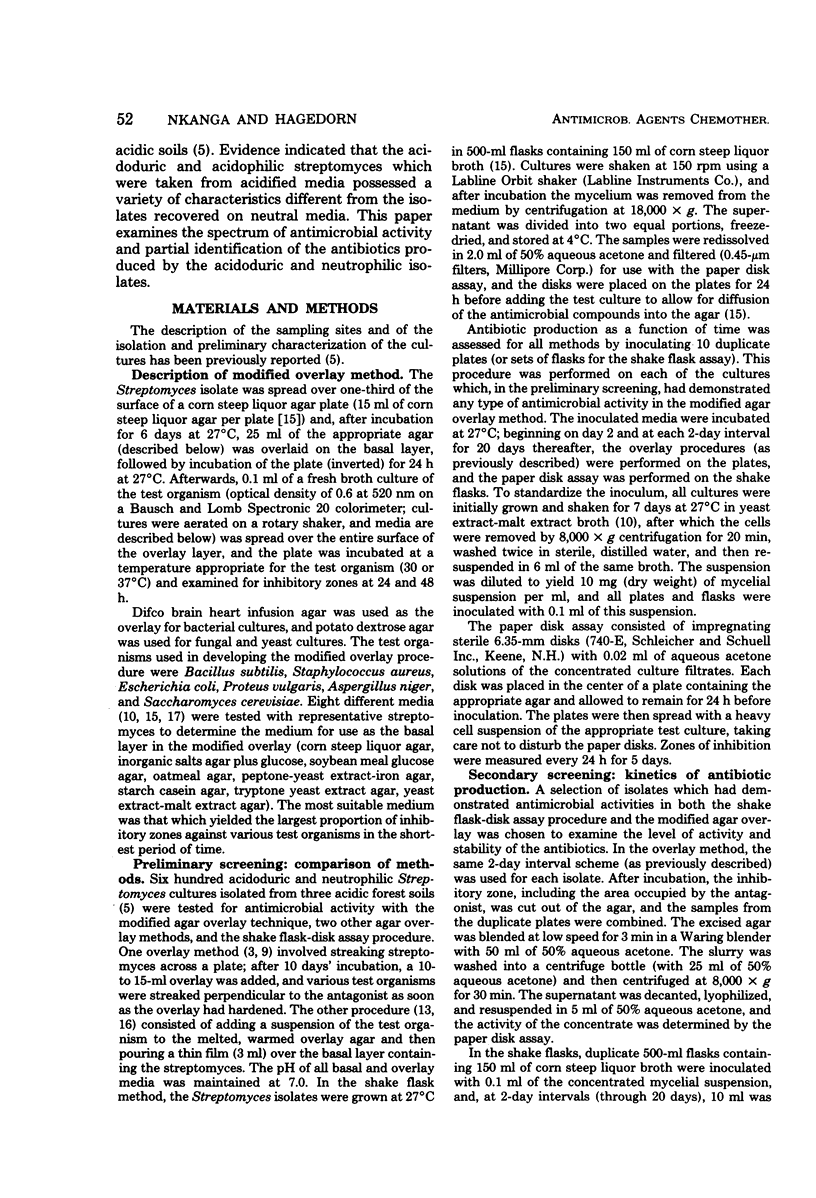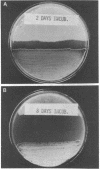Abstract
A modified agar overlay technique was developed for detecting antibiotic production by Streptomyces isolates and compared with two routinely used overlay procedures and the shake flask-disk assay method. Two types of inhibitory patterns could be discerned in the modified overlay method, and one of these was always exhibited by Streptomyces isolates which produced extractable antimicrobial substances. In a preliminary screening of 600 isolates, higher numbers of antibiotic-producing streptomyces were detected with the modified overlay procedure than with the streak or pour overlay method and the shake flask assay. The modified overlay distinguished between antibiotic production and other antagonistic effects. The inhibitory agents extracted after 6 days of culture growth on the modified overlay agar were of a higher concentration and more stable over longer periods of time than those recovered from shake flasks. It was observed that acidoduric streptomyces produced a greater proportion of antibiotics against gram-negative bacteria than did neutrophilic cultures, and this effect was greatest with the isolates from the most acidic soils. The neutrophiles were more active against gram-positive bacteria and, upon antibiotic classification, it appeared that the neutrophilic and acidoduric cultures from various soils produced different antimicrobial compounds.
Full text
PDF








Images in this article
Selected References
These references are in PubMed. This may not be the complete list of references from this article.
- Arai T., Mikami Y. Chromogenicity of Streptomyces. Appl Microbiol. 1972 Feb;23(2):402–406. doi: 10.1128/am.23.2.402-406.1972. [DOI] [PMC free article] [PubMed] [Google Scholar]
- BETINA V. A SYSTEMATIC ANALYSIS OF ANTIBIOTICS USING PAPER CHROMATOGRAPHY. J Chromatogr. 1964 Aug;15:379–392. doi: 10.1016/s0021-9673(01)82795-3. [DOI] [PubMed] [Google Scholar]
- Bryson V., Szybalski W. Microbial Selection. Science. 1952 Jul 18;116(3003):45–51. doi: 10.1126/science.116.3003.45. [DOI] [PubMed] [Google Scholar]
- Hagedorn C. Influences of soil acidity on Streptomyces populations inhabiting forest soils. Appl Environ Microbiol. 1976 Sep;32(3):368–375. doi: 10.1128/aem.32.3.368-375.1976. [DOI] [PMC free article] [PubMed] [Google Scholar]
- KUESTER E., WILLIAMS S. T. SELECTION OF MEDIA FOR ISOLATION OF STREPTOMYCETES. Nature. 1964 May 30;202:928–929. doi: 10.1038/202928a0. [DOI] [PubMed] [Google Scholar]
- Kelner A. A Method for Investigating Large Microbial Populations for Antibiotic Activity. J Bacteriol. 1948 Aug;56(2):157–162. doi: 10.1128/jb.56.2.157-162.1948. [DOI] [PMC free article] [PubMed] [Google Scholar]
- Loo Y. H., Skell P. S., Thornberry H. H., Ehrlich J., McGuire J. M., Savage G. M., Sylvester J. C. Assay of Streptomycin by the Paper-Disc Plate Method. J Bacteriol. 1945 Dec;50(6):701–709. [PMC free article] [PubMed] [Google Scholar]
- Majumdar M. K., Majumdar S. K. Isolation and characterization of three phosphoamido-neomycins and their conversion into neomycin by Streptomyces fradiae. Biochem J. 1970 Nov;120(2):271–278. doi: 10.1042/bj1200271. [DOI] [PMC free article] [PubMed] [Google Scholar]
- WILLIAMS S. T., DAVIES F. L. USE OF ANTIBIOTICS FOR SELECTIVE ISOLATION AND ENUMERATION OF ACTINOMYCETES IN SOIL. J Gen Microbiol. 1965 Feb;38:251–261. doi: 10.1099/00221287-38-2-251. [DOI] [PubMed] [Google Scholar]



